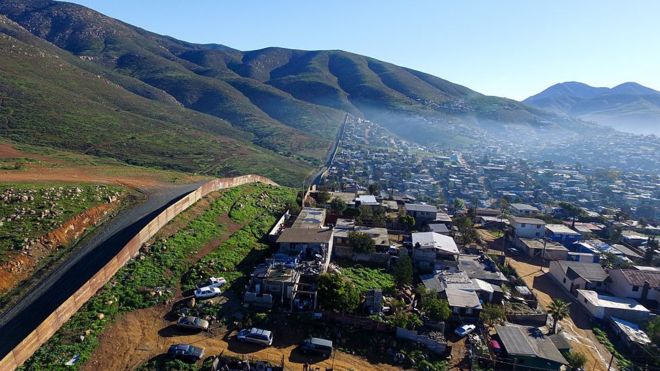As interior secretary Ryan Zinke arrived in Bears Ears national monument in southeastern Utah earlier this week to calm fears over proposals to reduce or redesignate 27 national monuments across 11 states, Taos Pueblo warchief Curtis Sandoval issued a stern warning: “If they allow drilling in the canyons, they’ll set off the volcanoes.”
Sandoval was referring to the volcanic cones that lie in the steep canyons within the Rio Grande del Norte national monument, a spectacular northern New Mexico site that stretches across 242,500 acres from Taos Pueblo reservation land to beyond the Colorado line.
But his warning may be more metaphorical than literal. The region, with its long history of land and water disputes, is gearing up for another battle between conservatives who fear the federal government will push ranchers and businesses off the land, and environmentalists who suspect a giveaway to corporate interests.
The Trump administration’s decision to review the designation of the Rio Grande del Norte monument, as well as the Organ Mountains-Desert Peaks range 300 miles south toward Las Cruces, is bringing together a coalition of tribal leaders, sportsmen, ranchers, business owners and conservationists in opposition.
To many here, Zinke’s review is the first step in turning over monuments to become open federal land – which could in turn be transferred to state trust lands required to generate income for the state, often through mining and drilling for gas and oil.
There is broad agreement among the tribal councils representing the reservations and pueblos in the Rio Grande valley, among them Zuni, Navajo, Santo Domingo and Mescalero Apache, that the Del Norte and Organ Mountain monument designations must be maintained. To do otherwise would be to gut a rare advance in trust and co-operation.
“The government still owes the tribal peoples,” Sandoval said. “They have responsibilities they haven’t fulfilled. No matter what they say, it’s our responsibility to protect Del Norte and we have to tell President Trump he has a responsibility to protect it too.”
But the suspicion is that land protection is not what the administration has in mind. “We believe their plan is to get oil and minerals out of the ground,” Sandoval said. “But this is our land. We were never moved from here. We were raised to protect it and protect everything that lives here.”
Last month, the Department of the Interior invited public comment on monument designations created since 1996 that cover more than 100,000 acres. The review was ordered by President Trump, who described the designations under his predecessors as “a massive federal land grab” that “should never have happened.” Under the executive order, Zinke has been ordered to produce an interim report in 45 days and issue a final report within 120 days.
“The issue is whether the monument is the right vehicle,” Zinke said after touring Bears Ears. “What vehicle of public land is appropriate to preserve the cultural identity, to make sure the tribes have a voice and make sure you preserve the traditions of hunting and fishing and public access?”
But those words are unlikely to reassure Sandoval and his coalition, who consider the political drive threatening del Norte as originating with Utah Republicans, including Governor Gary Herbert and House natural resources chairman Rob Bishop, and the American Lands Council, a group backed by the fossil-fuel industry funded American Legislative Exchange Council, that has proposed the transfer all federal lands in the west back to willing states.
While Zinke said there is no predetermined outcome of his review, Sandoval noted that the secretary was accompanied to Bears Ears, a site covering 1.3 million acres that includes dozens of archeological sites, with an entourage of anti-monument politicians.
Tribal leaders in Utah said Zinke met with Bears Ears Inter-Tribal Coalition for a single, one-hour, closed-door meeting. Davis Filfred of the Navajo Nation said there wasn’t enough time to make their points, and it had seemed that Zinke was focused on listening to opponents of the monument, designed by Barack Obama in December.
After his four-day tour of the Bears Ears and another Utah site, Grand Staircase-Escalante, Zinke told reporters the pair “are the most controversial; I think everyone recognizes that.” He declared that his aim was not to upset settled policy. “There’s a lot of monuments that are frankly settled and not controversial at all.”
But Esther Garcia, the former mayor of Questa, a mining town north of Taos, who had played a significant role in petitioning President Obama to designate Rio Grande del Norte a monument in 2013 under the provisions of the 1906 Antiquities Act, said she was not reassured.
“We wanted our water and land protected and that’s the declaration President Obama signed,” she said. “If we don’t protect what we have, my people and the pueblo peoples, we’re going to become non-existent. We have a deep connection to this land and to the water but the federal government doesn’t understand our culture and heritage.”
Monument designations had helped to ensure greater protection for the land, she said, and businesses have also experienced a boost.
Garcia, an 11th-generation Hispanic, said that the monument designation had sharply boosted the number of visitors to the area, many who came to experience its natural beauty, which includes herds of elk and bighorn sheep, cougar, mountain lions, river otters and black bear.
“If they reverse the monument declaration it will be hard for our community because it brought economic development,” Garcia says. “With the BLM, we get a seat at the table when decisions are being made. If it goes back to the state, we don’t know what may happen.”
Indigenous or Hispanic representatives express little confidence in New Mexico’s Republican governor Susana Martinez, who has tended to side with landowners and developers on water and land issues in the state, if the monument land in the state is reduced or the designations gutted in their entirety.
If opposition here gathers into a broad alliance here, it will not be the first time; nearby Española was site of the Pueblo Uprising against the Spanish in 1680. In this era, Spanish descendants and native Americans will act in concert. “We have a long history of the Hispanic culture and the native culture getting along here,” says Sandoval.
But there is less likely to be agreement at other areas under review.
New Mexico’s Republican congressional representative Steve Pearce has proposed reducing the 490,000-acre Organ Mountains-Desert Peaks national monument to 54,800 acres, and described Obama’s expansion of the national monuments as an abuse of power.
Mark Allison, the executive director of the New Mexico Wilderness Alliance, believes Trump misunderstood the nature of existing federal protections. “It’s not that this was private land – this land always was protected by the federal government. All the national monuments designation did was to put it off limits to commercial development.”
Allison believes the Organ Mountain monument is one of the most under threat from the administration, after Bears Ears and Grand Staircase-Escalante in Utah.
“The corporate interests who want to develop this land don’t really understand how special and unique they are,” he said. “It’s really important that landscapes like this are protected. There are incredible cultural artifacts there, archaelogical sites, sacred sites, historical sites. From an ecological perspective, it’s also vital that that species facing to climate change have the room to adapt.”
(TheGuardian US)






